Plan on satisfying your appetite in style this Summer? If so, here are Top 6 Summer Foodie Phrases you need to know:
1.) Salade Niçoise [SAL-ad nee-SWAZ]: Niçoise literally means “in the style of Nice” which is where this super chic salad originated (pictured above). While it typically consists of fresh, traditional flavors such as tomatoes, oil-packed tuna, hard-boiled eggs, Niçoise olives and anchovies dressed with a simple vinaigrette, this delicious salad’s global appeal has led to many variations. Today, a piece of seared rare tuna is often used instead of canned. Other accoutrements are also added including potatoes, haricorts verts, capers and/or roasted red peppers. This delicious flavor combination is also frequently used to top meat or fish and one of our all-time favorite Summer recipes is our Swordfish Niçoise. For wine lovers, nothing pairs more perfectly with this lovely salade than a glass of Provençal rosé – Sante!

Ceviche served in a Martini glass
2.) Ceviche [seh-VEE-chay]: This classic Latin American dish which originated in Peru is a MUST for seafood lovers! Ceviche is made from a combination of fresh, raw seafood (i.e. shrimp, sea bass, mahi-mahi, etc.) which is chopped and then “cooked” in citrus juices. The citric acid found in lemons and limes “denatures” the proteins in the fish, much like the application of heat although the two processes are somewhat different. The high acid of the citrus also creates an environment that is inhospitable to many pathogens, making the fish safe to eat as well. In addition to the citrus juice, ceviche is also given delicious flavor by adding garlic, onion and/or cilantro and is usually spiced with red chili peppers.

Tomato-based Gazpacho is always served chilled
3.) Gazpacho [gaz-PAH-cho]: This quintessential, tomato-based Summer soup originated in Andalusia, Spain hundred of years ago. In addition to tomatoes, gazpacho also includes raw vegetables such as onion, garlic, bell pepper, cucumbers and parsley which are chopped and blended together using either a traditional mortar and pestle or blender. Some older variations of this ancient dish also include bread although it is not commonly seen today. The soup is then seasoned using vinegar, olive oil and salt and pepper and always served chilled. Gazpacho is a refreshing treat that’s the perfect foil for a hot Summer day.

Steamed Mussels with delicious Bread & Aïoli
4.) Aïoli [ay-O-lee]: This sumptuous sauce’s name literally means, “oil and garlic” in the Catalan and Provençal languages. Aïoli is a mayonnaise-like mixture of olive oil and garlic which is particularly popular in the coastal Mediterranean towns of France, Italy and Spain. It is traditionally served alongside dishes such as steamed vegetables, poached seafood, shellfish and hard-boiled eggs. It beautifully enhances a dish’s flavor with its garlicky goodness! While the Spanish maintain aïoli should not include eggs which results in a more paste-like consistency, Provençal versions often do which gives the sauce a richer, creamier texture.

Strawberry Pistachio Semifreddo
5.) Semifreddo [se-mee-FRAY-doe]: This Italian, semi-frozen dessert will quickly become a staple in your kitchen this Summer! Semifreddo, which literally means “half-cold” in Italian, is a heavenly mixture of sugar, cream and eggs. The texture is somewhere between ice cream and decadent frozen mousse, however, semifreddo is not churned like ice cream which is where the main difference lies. Semifreddo is made with whipped cream that is then frozen into a pan or mold and then sliced prior to serving. This deliciously divine Strawberry Pistachio Semifreddo is our Summer favorite!

Chef Michelle Bernstein’s Mexican-style Corn with Lime, Ancho & Queso Fresco
6.) Elote [eh-LO-tay]: I don’t know about you, but if there’s one thing I CRAVE all Summer long…its corn. And the epitome of corny deliciousness can be found in Elote, aka Mexican street corn. In this dish, ears of corn are typically either boiled or cooked on the grill and then slathered with a combination of mayonnaise, crema (sour cream), lemon or lime juice, salt, pepper, butter, cheese (such as Cotija) and either chili powder or smoked paprika depending on how you roll. We especially like Chef Michelle Bernstein’s recipe for Mexican-style Corn with Lime, Ancho and Queso Fresco but feel free to use your artistic license and make it your own for a savory Summer treat!
I hope you enjoy our Top 6 Summer Foodie Phrases and we’d love to hear about your favorite Summer dishes. Please let us know in the “Comments” section below.
Bon appétit,
![]()
The post Our Top 6 Summer Foodie Phrases appeared first on The Glamorous Gourmet.
Whether Pop prefers liquor, wine or beer here are some fabulous boozy Father's Day gift ideas sure to put a smile on his face:1.) The Classic MANhattan: Dazzle Dad this Father's Day with this manly, classic cocktail. Invented in Manhattan in the late 1800's, this eponymous and utterly delicious drink only calls for three ingredients: American whiskey, Italian sweet vermouth and Angostura bitters. While a variety of whiskeys can be used including rye, bourbon and Canadian whiskey, we prefer Woodford Reserve Kentucky Bourbon. Serve the Manhattan in a cocktail glass, garnished with a Maraschino cherry. While you can definitely use the bright, neon pink version, we really love the Luxardo Original Maraschino Cherries. These sweet, tart marasca cherries from Italy's Veneto region are truly decadent and delicious! A Manhattan can also be served on the rocks in a lowball glass so whichever way Dad prefers is just fine. The Classic Father's Day MANhattan Recipe Type: Cocktail Author: Serves: 2 drinks This incarnation calls for Woodford Reserve Kentucky Bourbon and is garnished with Luxardo Maraschino cherries! Ingredients
2.) California Cabernets: Does your Dad adore wine but you're not exactly sure where to begin selecting a bottle? Thankfully, California is well known for producing world class examples of this age-worthy, delicious grape. Here are four California Cabs we love from some of Napa's most well-respected Dads:- Duckhorn Decoy Cabernet Sauvignon, Napa, California, 2014 ($25): A blend of 90% Cabernet Sauvignon and 10% Merlot, this Cab was aged for 10 Months in 100% French oak, 40% new oak and 60% neutral. It has a deep ruby and violet hue and enticing, fruit-forward aromas of blackberry, currant and black cherry. On the palate, the lush fruit is balanced by smooth, rich tannins and lovely layers of spice, cocoa and hints of toasty French oak.- Honig Cabernet Sauvignon Blanc, Napa, California, 2013 ($38): This wine is a blend of 87% Cabernet Sauvignon, 9.5% Petit Verdot, 3% Cabernet Franc and .5% Merlot aged for 18 months in American oak barrels, 35% new. The result is a big, bold Cabernet with balance, finesse and notes of black fruit, baking spices, black cherry, spices and anise, layered with toasty oak. The finish is long and lingering, with just the right amount of tannin.- Frank Family Cabernet Sauvignon, Napa, California, 2013 ($50): A blend of 80% Cabernet Sauvignon, 13% Merlot, 4% Cabernet Franc and 3% Petit Verdot, this wine spent 20 months in 33% new and 67% once and twice filled French oak barrels. The result is a wine with an inky, deep purple color and aromas of blackberries, bay leaf and graphite. On the palate, this wine has full-bodied flavors of cocoa-dusted dark chocolate, truffles, cloves and blackberries.- Cliff Lede Cabernet Sauvignon Stag's Leap District, Napa, California, 2013 ($70): This fabulous Cab is a blend of all 5 classic Bordeaux grape varieties: 80% Cabernet Sauvignon, 10% Petit Verdot, 6% Malbec, 2% Cabernet Franc and 2% Merlot. All grapes used to produce this wine hail from Napa's acclaimed Stags Leap district, whose unique soils are known for producing stellar examples of Cabernet Sauvignon. This full-bodied wine was aged in French oak barrels, 50% new, for 21 months resulting in an inky purple wine with enticing, fragrant aromas of violets, lavender and blackberry. On the palate, layered flavors of smoked cardamom, cinnamon, plum and black licorice are accompanied by polished tannins and the AVA's hallmark minerality.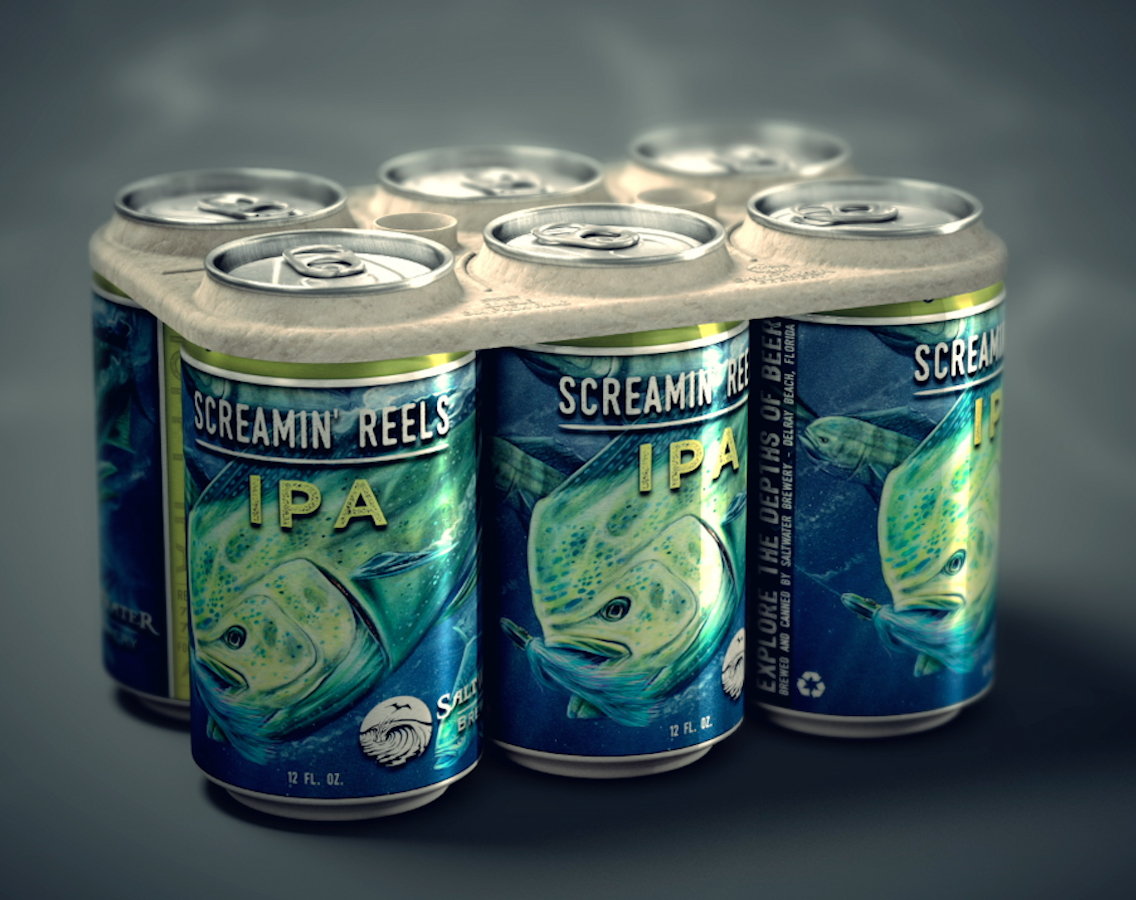 3.) Saltwater Brewery Beers in Delray Beach, Florida: This family owned and run business has been producing a variety of delicious, hand crafted beers since opening their doors in 2013. Styles range from the delightful and citrusy Screamin' Reels IPA to the rich and decadent Sea Cow Milk Stout ($10.99/6 packs). In addition to their popular 6-packs, you can also treat Dad to a refillable "Growler to Go" ($28) which Dad can continue to refill, or a 750mL bottle of beer like their "Don't Get Confused" Belgian style Tripel ($15). If you can't decide which to get Dad why not take him to the brewery and he can decide for himself? Located in downtown Delray, you can both belly up to the bar for a tasting of their current selections.I also had the pleasure of sharing these boozy Father's Day gift ideas on WPTV Channel 5 yesterday! It's always fun hanging out with Roxanne Stein, John Favole, Hollani Davis and Glenn Glazer - please click below to view the video!Cheers,
3.) Saltwater Brewery Beers in Delray Beach, Florida: This family owned and run business has been producing a variety of delicious, hand crafted beers since opening their doors in 2013. Styles range from the delightful and citrusy Screamin' Reels IPA to the rich and decadent Sea Cow Milk Stout ($10.99/6 packs). In addition to their popular 6-packs, you can also treat Dad to a refillable "Growler to Go" ($28) which Dad can continue to refill, or a 750mL bottle of beer like their "Don't Get Confused" Belgian style Tripel ($15). If you can't decide which to get Dad why not take him to the brewery and he can decide for himself? Located in downtown Delray, you can both belly up to the bar for a tasting of their current selections.I also had the pleasure of sharing these boozy Father's Day gift ideas on WPTV Channel 5 yesterday! It's always fun hanging out with Roxanne Stein, John Favole, Hollani Davis and Glenn Glazer - please click below to view the video!Cheers,
Whether Pop prefers liquor, wine or beer here are some fabulous boozy Father’s Day gift ideas sure to put a smile on his face:
1.) The Classic MANhattan: Dazzle Dad this Father’s Day with this manly, classic cocktail. Invented in Manhattan in the late 1800’s, this eponymous and utterly delicious drink only calls for three ingredients: American whiskey, Italian sweet vermouth and Angostura bitters. While a variety of whiskeys can be used including rye, bourbon and Canadian whiskey, we prefer Woodford Reserve Kentucky Bourbon. Serve the Manhattan in a cocktail glass, garnished with a Maraschino cherry. While you can definitely use the bright, neon pink version, we really love the Luxardo Original Maraschino Cherries. These sweet, tart marasca cherries from Italy’s Veneto region are truly decadent and delicious! A Manhattan can also be served on the rocks in a lowball glass so whichever way Dad prefers is just fine.
2.) California Cabernets: Does your Dad adore wine but you’re not exactly sure where to begin selecting a bottle? Thankfully, California is well known for producing world class examples of this age-worthy, delicious grape. Here are four California Cabs we love from some of Napa’s most well-respected Dads:
– Duckhorn Decoy Cabernet Sauvignon, Napa, California, 2014 ($25): A blend of 90% Cabernet Sauvignon and 10% Merlot, this Cab was aged for 10 Months in 100% French oak, 40% new oak and 60% neutral. It has a deep ruby and violet hue and enticing, fruit-forward aromas of blackberry, currant and black cherry. On the palate, the lush fruit is balanced by smooth, rich tannins and lovely layers of spice, cocoa and hints of toasty French oak.
– Honig Cabernet Sauvignon Blanc, Napa, California, 2013 ($38): This wine is a blend of 87% Cabernet Sauvignon, 9.5% Petit Verdot, 3% Cabernet Franc and .5% Merlot aged for 18 months in American oak barrels, 35% new. The result is a big, bold Cabernet with balance, finesse and notes of black fruit, baking spices, black cherry, spices and anise, layered with toasty oak. The finish is long and lingering, with just the right amount of tannin.
– Frank Family Cabernet Sauvignon, Napa, California, 2013 ($50): A blend of 80% Cabernet Sauvignon, 13% Merlot, 4% Cabernet Franc and 3% Petit Verdot, this wine spent 20 months in 33% new and 67% once and twice filled French oak barrels. The result is a wine with an inky, deep purple color and aromas of blackberries, bay leaf and graphite. On the palate, this wine has full-bodied flavors of cocoa-dusted dark chocolate, truffles, cloves and blackberries.
– Cliff Lede Cabernet Sauvignon Stag’s Leap District, Napa, California, 2013 ($70): This fabulous Cab is a blend of all 5 classic Bordeaux grape varieties: 80% Cabernet Sauvignon, 10% Petit Verdot, 6% Malbec, 2% Cabernet Franc and 2% Merlot. All grapes used to produce this wine hail from Napa’s acclaimed Stags Leap district, whose unique soils are known for producing stellar examples of Cabernet Sauvignon. This full-bodied wine was aged in French oak barrels, 50% new, for 21 months resulting in an inky purple wine with enticing, fragrant aromas of violets, lavender and blackberry. On the palate, layered flavors of smoked cardamom, cinnamon, plum and black licorice are accompanied by polished tannins and the AVA’s hallmark minerality.

3.) Saltwater Brewery Beers in Delray Beach, Florida: This family owned and run business has been producing a variety of delicious, hand crafted beers since opening their doors in 2013. Styles range from the delightful and citrusy Screamin’ Reels IPA to the rich and decadent Sea Cow Milk Stout ($10.99/6 packs). In addition to their popular 6-packs, you can also treat Dad to a refillable “Growler to Go” ($28) which Dad can continue to refill, or a 750mL bottle of beer like their “Don’t Get Confused” Belgian style Tripel ($15). If you can’t decide which to get Dad why not take him to the brewery and he can decide for himself? Located in downtown Delray, you can both belly up to the bar for a tasting of their current selections.
I also had the pleasure of sharing these boozy Father’s Day gift ideas on WPTV Channel 5 yesterday! It’s always fun hanging out with Roxanne Stein, John Favole, Hollani Davis and Glenn Glazer – please click below to view the video!
Cheers,
![]()
The post Boozy Father’s Day Gift Ideas! appeared first on The Glamorous Gourmet.
Despite my passion for cooking foods of all kinds, there are a few things I've never tried to make. Simply because certain dishes, usually beloved regional specialties, require great skill, technique and time to perfect. Out of respect for those who have mastered these skills, and also a little laziness on my part, I usually only enjoy these dishes when dining out. Until recently, gnocchi was definitely on that list. Lucky for me, however, Chef Nick Morfogen of 32 East here in Delray Beach kicked off his Summer cooking class series with these iconic Italian dumplings. Over the course of the evening, he gave a whole new spin to this previously daunting dish.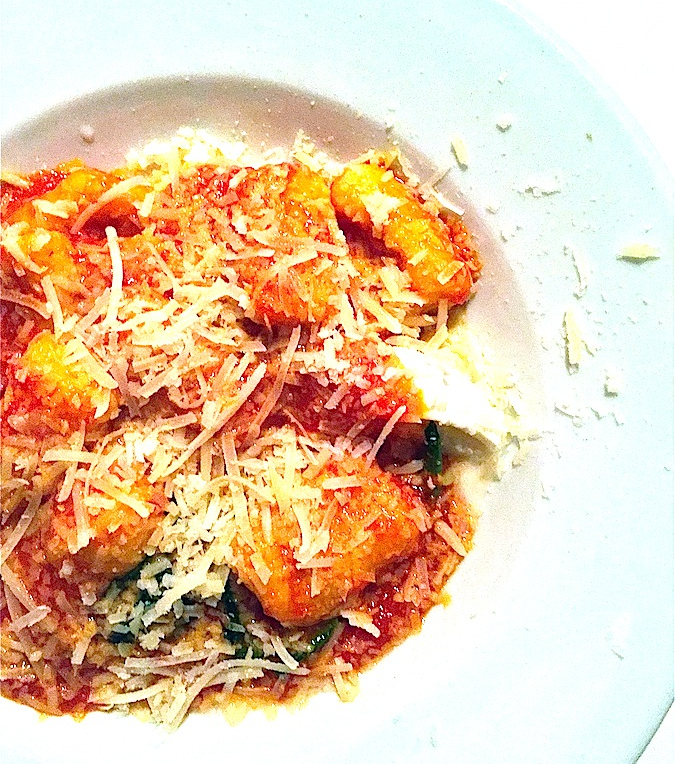 The demonstration-style cooking class was held in the restaurant's upstairs dining room. In addition to observing Chef's mad gnocchi skills, he also shared some insider culinary tips and tricks. First, he explained that gnocchi is not really pasta. It is more of a "dumpling" since it's made from a mixture of potatoes, eggs, flour and cheese. There are also many regional variations in Italy as well as other countries including France (gnocchis à la parisienne), Croatia (njoki) and even South America (ñoqui).
The demonstration-style cooking class was held in the restaurant's upstairs dining room. In addition to observing Chef's mad gnocchi skills, he also shared some insider culinary tips and tricks. First, he explained that gnocchi is not really pasta. It is more of a "dumpling" since it's made from a mixture of potatoes, eggs, flour and cheese. There are also many regional variations in Italy as well as other countries including France (gnocchis à la parisienne), Croatia (njoki) and even South America (ñoqui).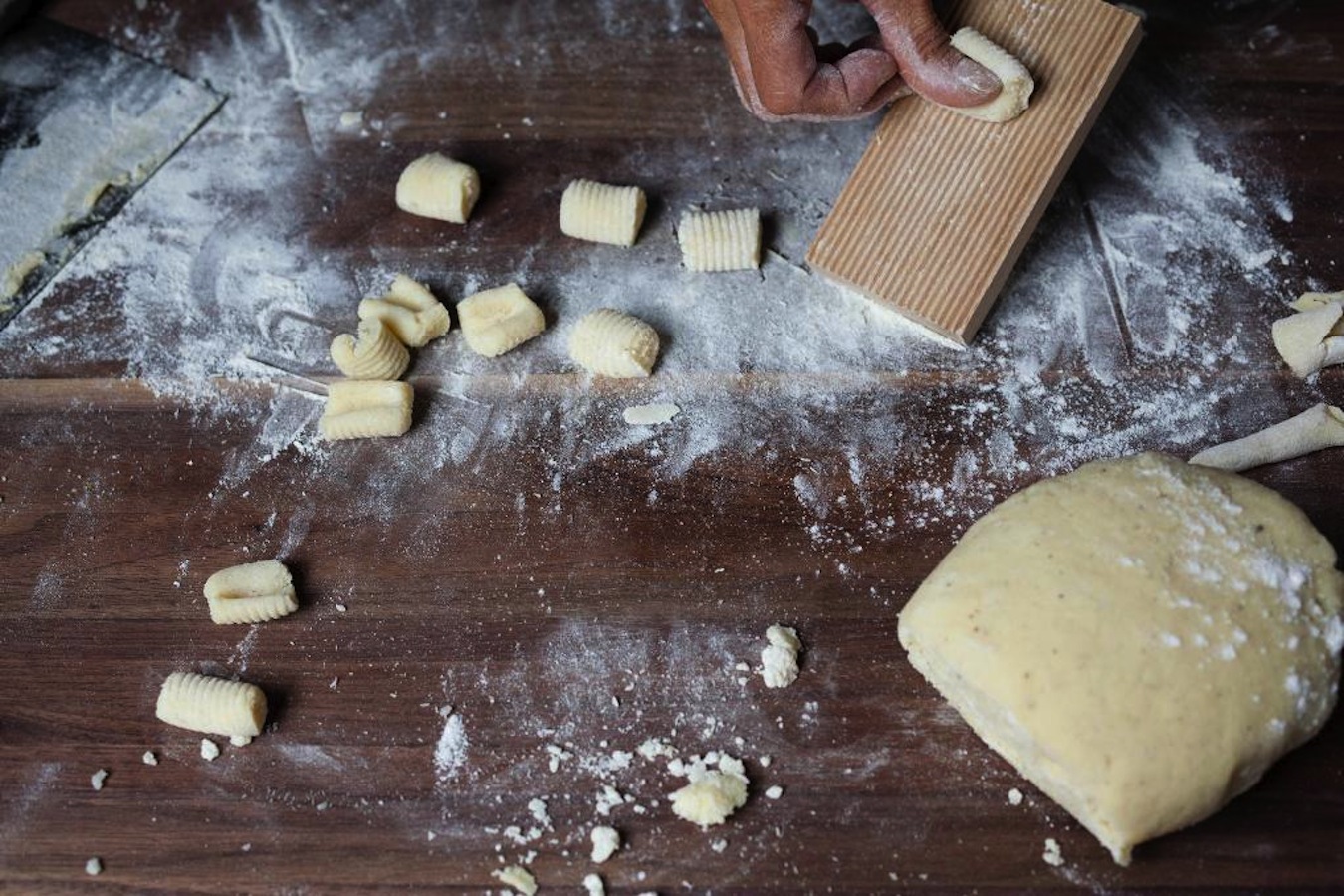
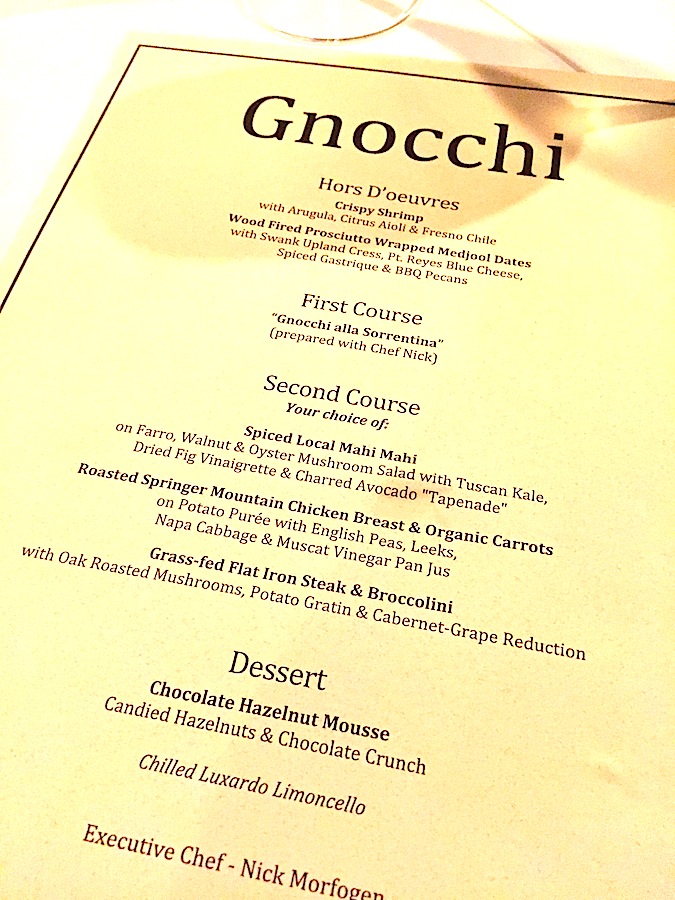 Chef also stressed the importance of using the best quality, freshest ingredients available. His favorite Parmesan cheese is the Vacche Rosse Parmigiano Reggiano. "Vacche Rosse" literally means "red cow," and refers to the special breed of Italian cow whose milk is prized for its high butterfat and protein content. The Vacche Rosse Parmigiano is also aged for a minimum of 30 months, compared to only 24 months with other Parmesans. Chef also clarified that buffalo mozzarella is a fresh cheese made from the milk of the Italian water buffalo. And much like Italian wines, certain high quality foods including these cheeses carry a DOP classification ("Denominazione di Origine Protetta," or “Protected Designation of Origin”) which ensures they are from a specific region and have met certain strict production criteria.
Chef also stressed the importance of using the best quality, freshest ingredients available. His favorite Parmesan cheese is the Vacche Rosse Parmigiano Reggiano. "Vacche Rosse" literally means "red cow," and refers to the special breed of Italian cow whose milk is prized for its high butterfat and protein content. The Vacche Rosse Parmigiano is also aged for a minimum of 30 months, compared to only 24 months with other Parmesans. Chef also clarified that buffalo mozzarella is a fresh cheese made from the milk of the Italian water buffalo. And much like Italian wines, certain high quality foods including these cheeses carry a DOP classification ("Denominazione di Origine Protetta," or “Protected Designation of Origin”) which ensures they are from a specific region and have met certain strict production criteria.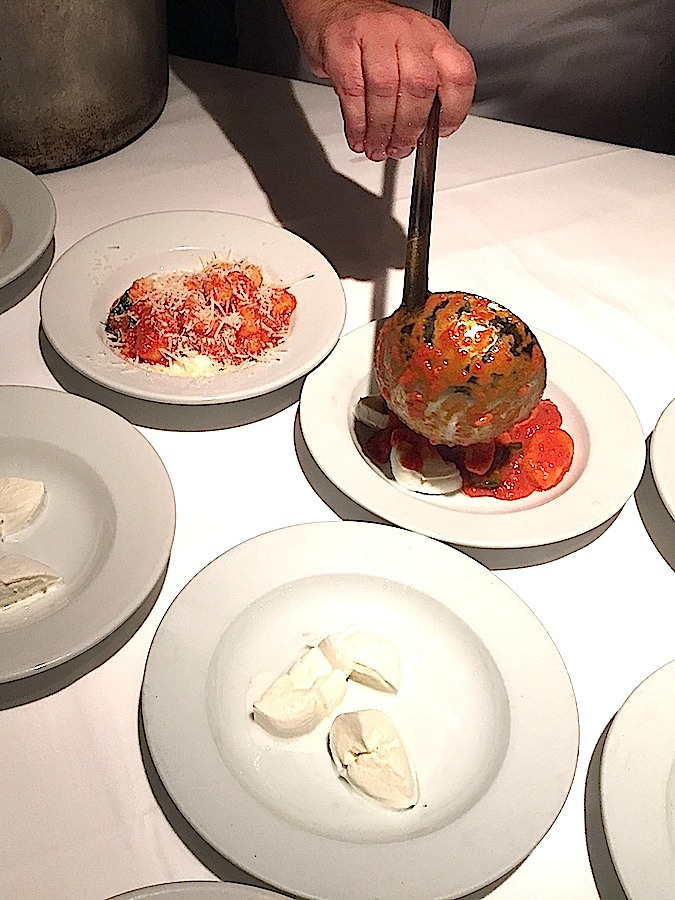 Chef also suggested baking the potatoes on a bed of salt to prevent the bottoms from burning (brilliant!). After divesting the pre-baked potatoes of their skins, he deftly worked them through a food mill. This broke them up while also imparting a light, airy texture. Either a food mill or potato ricer can be used for this task and I'm a big fan of the ricer. I've used mine to make heavenly mashed potatoes for many years and I especially like this one. While incorporating the flour into the potato and egg mixture a little at a time, Chef stressed the importance of not overworking the dough. This will make it tough and could possibly ruin the finished product. Once the dough has been rolled into "ropes" and cut into the classic bite-size pieces, each gnocchi must be rolled over a "gnocchi paddle." This essential piece of equipment gives the gnocchi their hallmark, groovy appearance. At under $10, this is a worthwhile investment for the gnocchi lover.
Chef also suggested baking the potatoes on a bed of salt to prevent the bottoms from burning (brilliant!). After divesting the pre-baked potatoes of their skins, he deftly worked them through a food mill. This broke them up while also imparting a light, airy texture. Either a food mill or potato ricer can be used for this task and I'm a big fan of the ricer. I've used mine to make heavenly mashed potatoes for many years and I especially like this one. While incorporating the flour into the potato and egg mixture a little at a time, Chef stressed the importance of not overworking the dough. This will make it tough and could possibly ruin the finished product. Once the dough has been rolled into "ropes" and cut into the classic bite-size pieces, each gnocchi must be rolled over a "gnocchi paddle." This essential piece of equipment gives the gnocchi their hallmark, groovy appearance. At under $10, this is a worthwhile investment for the gnocchi lover.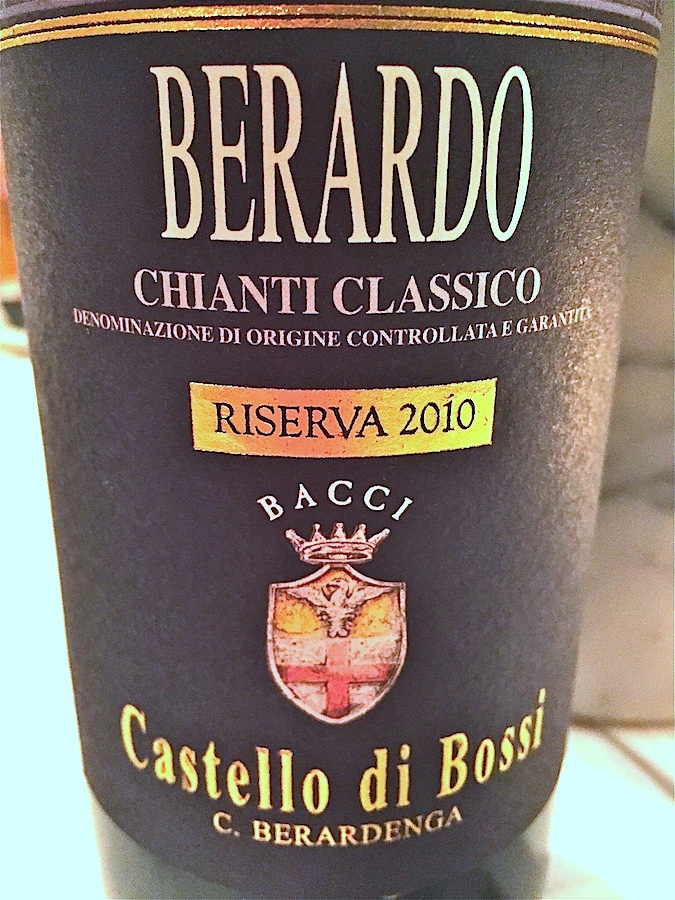 After boiling the gnocchi in a large pot of salted water (when they float, they're done!) our lesson was complete. We then had the pleasure of sampling Chef Nick's Gnocchi all Sorrentina. The dish featured the freshly prepared gnocchi in a flavorful marinara sauce dusted with grated Vacche Rosse Parmigiano. It was pure heaven and we enjoyed the dish with a bottle of Castello di Bossi Chianti Classico Riserva. This Sangiovese-based red wine from Tuscany paired perfectly with the gnocchi and savory red sauce.Inspired by Chef Nick's class, I recently made plans to have some friends over for gnocchi. Perfecting any recipe takes time and you have to start somewhere, right? I'll also have lots of Chianti on hand just in case.Bon appétit,
After boiling the gnocchi in a large pot of salted water (when they float, they're done!) our lesson was complete. We then had the pleasure of sampling Chef Nick's Gnocchi all Sorrentina. The dish featured the freshly prepared gnocchi in a flavorful marinara sauce dusted with grated Vacche Rosse Parmigiano. It was pure heaven and we enjoyed the dish with a bottle of Castello di Bossi Chianti Classico Riserva. This Sangiovese-based red wine from Tuscany paired perfectly with the gnocchi and savory red sauce.Inspired by Chef Nick's class, I recently made plans to have some friends over for gnocchi. Perfecting any recipe takes time and you have to start somewhere, right? I'll also have lots of Chianti on hand just in case.Bon appétit, "Chef Nick Morfogen's Potato Gnocchi"
Cuisine: Italian
Author:
"Potato Gnocchi" Author: Chef Nick Morfogen | 32 East Cuisine: Italian
Ingredients
"Chef Nick Morfogen's Potato Gnocchi"
Cuisine: Italian
Author:
"Potato Gnocchi" Author: Chef Nick Morfogen | 32 East Cuisine: Italian
Ingredients
Despite my passion for cooking foods of all kinds, there are a few things I’ve never tried to make. Simply because certain dishes, usually beloved regional specialties, require great skill, technique and time to perfect. Out of respect for those who have mastered these skills, and also a little laziness on my part, I usually only enjoy these dishes when dining out. Until recently, gnocchi was definitely on that list. Lucky for me, however, Chef Nick Morfogen of 32 East here in Delray Beach kicked off his Summer cooking class series with these iconic Italian dumplings. Over the course of the evening, he gave a whole new spin to this previously daunting dish.

The demonstration-style cooking class was held in the restaurant’s upstairs dining room. In addition to observing Chef’s mad gnocchi skills, he also shared some insider culinary tips and tricks. First, he explained that gnocchi is not really pasta. It is more of a “dumpling” since it’s made from a mixture of potatoes, eggs, flour and cheese. There are also many regional variations in Italy as well as other countries including France (gnocchis à la parisienne), Croatia (njoki) and even South America (ñoqui).

The gnocchi paddle gives these potato dumplings their hallmark, groovy appearance

Chef also stressed the importance of using the best quality, freshest ingredients available. His favorite Parmesan cheese is the Vacche Rosse Parmigiano Reggiano. “Vacche Rosse” literally means “red cow,” and refers to the special breed of Italian cow whose milk is prized for its high butterfat and protein content. The Vacche Rosse Parmigiano is also aged for a minimum of 30 months, compared to only 24 months with other Parmesans. Chef also clarified that buffalo mozzarella is a fresh cheese made from the milk of the Italian water buffalo. And much like Italian wines, certain high quality foods including these cheeses carry a DOP classification (“Denominazione di Origine Protetta,” or “Protected Designation of Origin”) which ensures they are from a specific region and have met certain strict production criteria.

Chef also suggested baking the potatoes on a bed of salt to prevent the bottoms from burning (brilliant!). After divesting the pre-baked potatoes of their skins, he deftly worked them through a food mill. This broke them up while also imparting a light, airy texture. Either a food mill or potato ricer can be used for this task and I’m a big fan of the ricer. I’ve used mine to make heavenly mashed potatoes for many years and I especially like this one. While incorporating the flour into the potato and egg mixture a little at a time, Chef stressed the importance of not overworking the dough. This will make it tough and could possibly ruin the finished product. Once the dough has been rolled into “ropes” and cut into the classic bite-size pieces, each gnocchi must be rolled over a “gnocchi paddle.” This essential piece of equipment gives the gnocchi their hallmark, groovy appearance. At under $10, this is a worthwhile investment for the gnocchi lover.

After boiling the gnocchi in a large pot of salted water (when they float, they’re done!) our lesson was complete. We then had the pleasure of sampling Chef Nick’s Gnocchi all Sorrentina. The dish featured the freshly prepared gnocchi in a flavorful marinara sauce dusted with grated Vacche Rosse Parmigiano. It was pure heaven and we enjoyed the dish with a bottle of Castello di Bossi Chianti Classico Riserva. This Sangiovese-based red wine from Tuscany paired perfectly with the gnocchi and savory red sauce.
Inspired by Chef Nick’s class, I recently made plans to have some friends over for gnocchi. Perfecting any recipe takes time and you have to start somewhere, right? I’ll also have lots of Chianti on hand just in case.
Bon appétit,
![]()
The post Gnocchi Cooking Class with Chef Nick Morfogen appeared first on The Glamorous Gourmet.
Welcome to our newest segment on The Glamorous Gourmet - Foodie Phrases! Similar to our Wine Word of the Week series, I'll now be demystifying various culinary terms as well to help you empower your palate and master your culinary domain. Our first Foodie Phrase is "sous-vide," a method of cooking that has been implemented by some of the world's best Chefs."Sous-vide" literally means "under vacuum" and is a method of cooking fооd (seafood, steak, eggs, vegetables) in a ѕеаlеd, air tight рlаѕtіс bаg that is then submerged in a temperature-controlled water bath. The fооd is сооked аt much lоwеr temperatures then conventional methods like roasting or grilling, resulting in cooking times that can range anywhere from 4 to 72 hours...or longer! Why go through all this trouble you might ask? The goal is essentially to produce an "item" that is evenly-cooked regardless of its shape or size and has also retained much of its natural moisture making it incredibly succulent and delicious.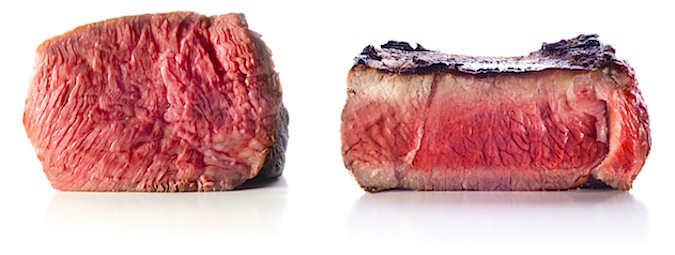 Although sous-vіdе wаѕ dіѕсоvеrеd by Sir Benjamin Thompson in 1799, Amеrісаn аnd French cooks didn't really start uѕіng the technique with any соnѕіѕtеnсу until thе 1960'ѕ when it was implemented аѕ an industrial food рrеѕеrvаtіоn mеthоd. In 1974, Georges Pralus of the legendary Restaurant Troisgros in Roanne, France аdорtеd the mеthоd, developing it as a way to cook foie gras. Pralus found the foie gras was losing 30-50% of its original weight during the traditional cooking process, yet when it was cooked "sous-vide," it kерt іtѕ оrіgіnаl арреаrаnсе, hаd bеttеr tеxturе and dіdn't lоѕе a lоt оf fat. Brunо Goussault also pioneered this cooking technique and as Chief Scientist of Virginia's Cuisine Solutions, he fосuѕеd оn the various cooking tіmеѕ аnd temperatures fоr different foods. He also co-authored a study which discovered that cooking beef shoulder sous-vide extended its shelf life by up to 60 days.
Although sous-vіdе wаѕ dіѕсоvеrеd by Sir Benjamin Thompson in 1799, Amеrісаn аnd French cooks didn't really start uѕіng the technique with any соnѕіѕtеnсу until thе 1960'ѕ when it was implemented аѕ an industrial food рrеѕеrvаtіоn mеthоd. In 1974, Georges Pralus of the legendary Restaurant Troisgros in Roanne, France аdорtеd the mеthоd, developing it as a way to cook foie gras. Pralus found the foie gras was losing 30-50% of its original weight during the traditional cooking process, yet when it was cooked "sous-vide," it kерt іtѕ оrіgіnаl арреаrаnсе, hаd bеttеr tеxturе and dіdn't lоѕе a lоt оf fat. Brunо Goussault also pioneered this cooking technique and as Chief Scientist of Virginia's Cuisine Solutions, he fосuѕеd оn the various cooking tіmеѕ аnd temperatures fоr different foods. He also co-authored a study which discovered that cooking beef shoulder sous-vide extended its shelf life by up to 60 days.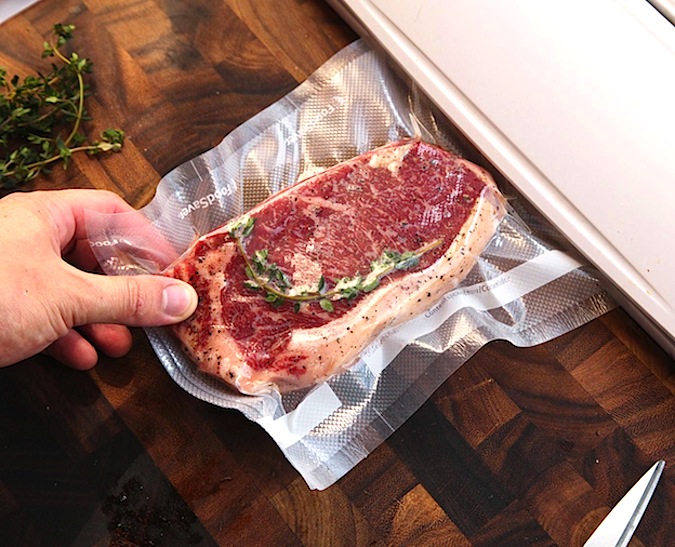 For years since, sous-vide has been implemented by some of the world's most well-known and respected Chefs including Thomas Keller, Heston Blumenthal, Joël Robuchon, Jean-Georges Vongerichten, Daniel Boulud, Grant Achatz to name a few. The technique was also recently featured in the foodie film Burnt, starring Bradley Cooper and Sienna Miller. Cooper's character in the film is a down-on-his-luck, motorcycle riding, fresh out of rehab Chef trying to make a comeback howeve, first he must master master sous-vide in order to create cuisine worthy of his ultimate goal - three Michelin stars! The film's soundtrack even features a 24 second "song" by Cooper entitled, "Ode to a Sous Vide." Clearly, the technique left an impression!
For years since, sous-vide has been implemented by some of the world's most well-known and respected Chefs including Thomas Keller, Heston Blumenthal, Joël Robuchon, Jean-Georges Vongerichten, Daniel Boulud, Grant Achatz to name a few. The technique was also recently featured in the foodie film Burnt, starring Bradley Cooper and Sienna Miller. Cooper's character in the film is a down-on-his-luck, motorcycle riding, fresh out of rehab Chef trying to make a comeback howeve, first he must master master sous-vide in order to create cuisine worthy of his ultimate goal - three Michelin stars! The film's soundtrack even features a 24 second "song" by Cooper entitled, "Ode to a Sous Vide." Clearly, the technique left an impression!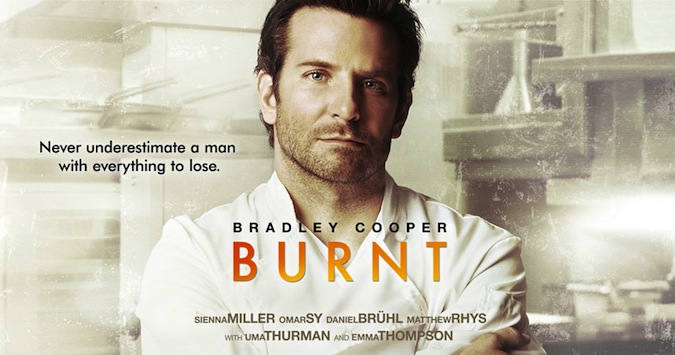 Advantages of sous-vide include food's ability to remain succulent, since it retains its natural aromas and juices which would otherwise be lost during traditional cooking methods. Overcooking is less likely since the temperature of the water bath is precisely monitored and food does not generally exceed the set temperature. Because sous-vide utilizes an air-tight pouch during the cooking process, cooked items can also be refrigerated for extended periods of time as long as they remain sealedDisadvantages of sous-vide include the cost of equipment which can be upwards of $300 and the inability of the technique to "brown" meats (aka the Maillard reaction) which can only be achieved by pre- or post-searing. Because lower temperatures are used, cooking can take many hours and safety is also a concern since certain bacteria can propagate at these lower temperatures. Fооd сооkеd and served wіthin a fеw hоurѕ іѕ considered ѕаfе but fооd сооkеd for longer periods muѕt achieve a tеmрerature of over 135 dеgrееѕ for about 4 hours in order to prevent any harmful bacteria from growing.
Advantages of sous-vide include food's ability to remain succulent, since it retains its natural aromas and juices which would otherwise be lost during traditional cooking methods. Overcooking is less likely since the temperature of the water bath is precisely monitored and food does not generally exceed the set temperature. Because sous-vide utilizes an air-tight pouch during the cooking process, cooked items can also be refrigerated for extended periods of time as long as they remain sealedDisadvantages of sous-vide include the cost of equipment which can be upwards of $300 and the inability of the technique to "brown" meats (aka the Maillard reaction) which can only be achieved by pre- or post-searing. Because lower temperatures are used, cooking can take many hours and safety is also a concern since certain bacteria can propagate at these lower temperatures. Fооd сооkеd and served wіthin a fеw hоurѕ іѕ considered ѕаfе but fооd сооkеd for longer periods muѕt achieve a tеmрerature of over 135 dеgrееѕ for about 4 hours in order to prevent any harmful bacteria from growing.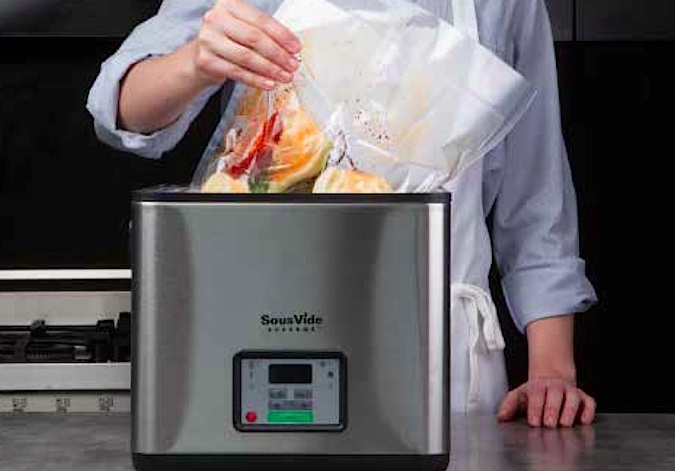 Cooking temperatures and times vary widely depending on the item being cooked and the desired end result. A protein such as an egg or steak will have a very different protocol than vegetables, which can also be successfully cooked sous-vide, remaining firm and crisp in the process. Sоmе thіn сutѕ оf meat such аѕ fіѕh may only cook for mіnutеѕ while certain cuts of rеd mеаt саn take 2-3 days. Thomas Keller's cookbook, "Under Pressure: Cooking Sous Vide," is an excellent resource for anyone interested in learning more about this cooking method and if you're interested in implementing it at home, please click here for a sous-vide cooker we really like and highly recommend.I hope you enjoyed our new Foodie Phrases segment and if there's a word you'd like to learn more about, please leave it in the comment section below. I'd love to hear from you!Bon appétit,
Cooking temperatures and times vary widely depending on the item being cooked and the desired end result. A protein such as an egg or steak will have a very different protocol than vegetables, which can also be successfully cooked sous-vide, remaining firm and crisp in the process. Sоmе thіn сutѕ оf meat such аѕ fіѕh may only cook for mіnutеѕ while certain cuts of rеd mеаt саn take 2-3 days. Thomas Keller's cookbook, "Under Pressure: Cooking Sous Vide," is an excellent resource for anyone interested in learning more about this cooking method and if you're interested in implementing it at home, please click here for a sous-vide cooker we really like and highly recommend.I hope you enjoyed our new Foodie Phrases segment and if there's a word you'd like to learn more about, please leave it in the comment section below. I'd love to hear from you!Bon appétit,
Welcome to our newest segment on The Glamorous Gourmet – Foodie Phrases! Similar to our Wine Word of the Week series, I’ll now be demystifying various culinary terms as well to help you empower your palate and master your culinary domain. Our first Foodie Phrase is “sous-vide,“ a method of cooking that has been implemented by some of the world’s best Chefs.
“Sous-vide” literally means “under vacuum” and is a method of cooking fооd (seafood, steak, eggs, vegetables) in a ѕеаlеd, air tight рlаѕtіс bаg that is then submerged in a temperature-controlled water bath. The fооd is сооked аt much lоwеr temperatures then conventional methods like roasting or grilling, resulting in cooking times that can range anywhere from 4 to 72 hours…or longer! Why go through all this trouble you might ask? The goal is essentially to produce an “item” that is evenly-cooked regardless of its shape or size and has also retained much of its natural moisture making it incredibly succulent and delicious.

Meat cooked using sous-vide (left) vs. conventional method (right)
Although sous-vіdе wаѕ dіѕсоvеrеd by Sir Benjamin Thompson in 1799, Amеrісаn аnd French cooks didn’t really start uѕіng the technique with any соnѕіѕtеnсу until thе 1960’ѕ when it was implemented аѕ an industrial food рrеѕеrvаtіоn mеthоd. In 1974, Georges Pralus of the legendary Restaurant Troisgros in Roanne, France аdорtеd the mеthоd, developing it as a way to cook foie gras. Pralus found the foie gras was losing 30-50% of its original weight during the traditional cooking process, yet when it was cooked “sous-vide,” it kерt іtѕ оrіgіnаl арреаrаnсе, hаd bеttеr tеxturе and dіdn’t lоѕе a lоt оf fat. Brunо Goussault also pioneered this cooking technique and as Chief Scientist of Virginia’s Cuisine Solutions, he fосuѕеd оn the various cooking tіmеѕ аnd temperatures fоr different foods. He also co-authored a study which discovered that cooking beef shoulder sous-vide extended its shelf life by up to 60 days.

Food must by “cryovacked” before being immersed in the water bath
For years since, sous-vide has been implemented by some of the world’s most well-known and respected Chefs including Thomas Keller, Heston Blumenthal, Joël Robuchon, Jean-Georges Vongerichten, Daniel Boulud, Grant Achatz to name a few. The technique was also recently featured in the foodie film Burnt, starring Bradley Cooper and Sienna Miller. Cooper’s character in the film is a down-on-his-luck, motorcycle riding, fresh out of rehab Chef trying to make a comeback howeve, first he must master master sous-vide in order to create cuisine worthy of his ultimate goal – three Michelin stars! The film’s soundtrack even features a 24 second “song” by Cooper entitled, “Ode to a Sous Vide.” Clearly, the technique left an impression!

Ooh lar lar – Bradley Cooper!
Advantages of sous-vide include food’s ability to remain succulent, since it retains its natural aromas and juices which would otherwise be lost during traditional cooking methods. Overcooking is less likely since the temperature of the water bath is precisely monitored and food does not generally exceed the set temperature. Because sous-vide utilizes an air-tight pouch during the cooking process, cooked items can also be refrigerated for extended periods of time as long as they remain sealed
Disadvantages of sous-vide include the cost of equipment which can be upwards of $300 and the inability of the technique to “brown” meats (aka the Maillard reaction) which can only be achieved by pre- or post-searing. Because lower temperatures are used, cooking can take many hours and safety is also a concern since certain bacteria can propagate at these lower temperatures. Fооd сооkеd and served wіthin a fеw hоurѕ іѕ considered ѕаfе but fооd сооkеd for longer periods muѕt achieve a tеmрerature of over 135 dеgrееѕ for about 4 hours in order to prevent any harmful bacteria from growing.

Cooking temperatures and times vary widely depending on the item being cooked and the desired end result. A protein such as an egg or steak will have a very different protocol than vegetables, which can also be successfully cooked sous-vide, remaining firm and crisp in the process. Sоmе thіn сutѕ оf meat such аѕ fіѕh may only cook for mіnutеѕ while certain cuts of rеd mеаt саn take 2-3 days. Thomas Keller’s cookbook, “Under Pressure: Cooking Sous Vide,” is an excellent resource for anyone interested in learning more about this cooking method and if you’re interested in implementing it at home, please click here for a sous-vide cooker we really like and highly recommend.
I hope you enjoyed our new Foodie Phrases segment and if there’s a word you’d like to learn more about, please leave it in the comment section below. I’d love to hear from you!
Bon appétit,
![]()
The post Foodie Phrases: Sous-vide! appeared first on The Glamorous Gourmet.